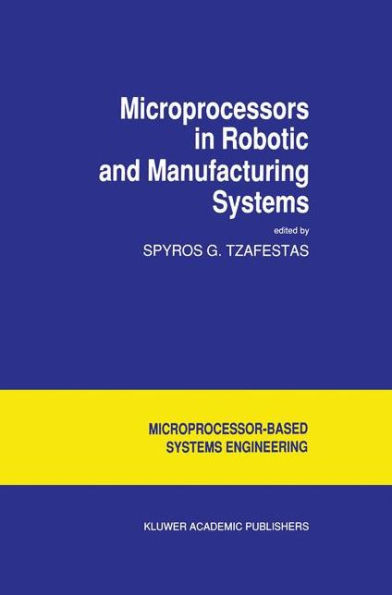5
1
9780792307808


$219.99

Microprocessors in Robotic and Manufacturing Systems / Edition 1 available in Hardcover

Microprocessors in Robotic and Manufacturing Systems / Edition 1
by S.G. Tzafestas
S.G. Tzafestas
- ISBN-10:
- 0792307801
- ISBN-13:
- 9780792307808
- Pub. Date:
- 10/31/1991
- Publisher:
- Springer Netherlands
- ISBN-10:
- 0792307801
- ISBN-13:
- 9780792307808
- Pub. Date:
- 10/31/1991
- Publisher:
- Springer Netherlands

Microprocessors in Robotic and Manufacturing Systems / Edition 1
by S.G. Tzafestas
S.G. Tzafestas
Hardcover
Buy New
$219.99
$219.99
219.99
In Stock
Overview
Microprocessors play a dominant role in computer technology and have contributed uniquely in the development of many new concepts and design techniques for modem industrial systems. This contribution is excessively high in the area of robotic and manufacturing systems. However, it is the editor's feeling that a reference book describing this contribution in a cohesive way and covering the major hardware and software issues is lacking. The purpose of this book is exactly to fill in this gap through the collection and presentation of the experience of a number of experts and professionals working in different academic and industrial environments. The book is divided in three parts. Part 1 involves the first four chapters and deals with the utilization of microprocessors and digital signal processors ( DSPs ) for the computation of robot dynamics. The emphasis here is on parallel computation with particular problems attacked being task granularity, task allocation/scheduling and communication issues. Chapter I, by Zheng and Hemami, is concerned with the real-time multiprocessor computation of torques in robot control systems via the Newton-Euler equations. This reduces substantially the height of the evaluation tree which leads to more effective parallel processing. Chapter 2, by D'Hollander, examines thoroughly the automatic scheduling of the Newton-Euler inverse dynamic equations. The automatic program decomposition and scheduling techniques developed are embedded in a tool used to generate multiprocessor schedules from a high-level language program.

Product Details
| ISBN-13: | 9780792307808 |
|---|---|
| Publisher: | Springer Netherlands |
| Publication date: | 10/31/1991 |
| Series: | Intelligent Systems, Control and Automation: Science and Engineering , #6 |
| Edition description: | 1991 |
| Pages: | 411 |
| Product dimensions: | 6.10(w) x 9.25(h) x 0.36(d) |
Table of Contents
I Robotic Computations.- 1 Computation of Robot Dynamics by a Multiprocessor Scheme.- 1. Introduction.- 2. Tree-Height Reduction by Newton-Euler State Space Equations.- 3. The Multiprocessor System and the Task Allocation.- 4. Performance Evaluation.- 5. Parallel Processing for a Two Link Robot System.- 6. Conclusion.- References.- 2 Automatic Scheduling of the Newton-Euler Inverse Dynamics.- 1. Introduction.- 2. Task Granularity and Communication Overhead.- 3. The Newton-Euler Inverse Dynamics.- 4. Automatic Data-Flow Analysis: the LEM Analyzer.- 5. Parallel Execution.- 6. Conclusion.- References.- 3 Numerical Applications of DSPs in Robotic Computations.- 1. Introduction.- 2. A Survey of the Main Characteristics of DSPs.- 3. Numerical Applications in Robotic Computations.- 4. Conclusions.- References.- 4 Parallel Processing of Robot Control and Simulation.- 1. Introduction.- 2. Parallel Processing of Robot-Arm Control Computation.- 3. Parallel Processing of Robot Dynamics Simulation.- 4. Summary and Future Directions.- References.- 2 Robotic Control and Vision.- 5 Microprocessor-Based Controllers for Robotic Manipulators.- 1. Introduction.- 2. Survey of Microprocessor-Based Controllers.- 3. Techniques to Improve Microprocessor-Based Controller Implementation.- 4. Conclusions.- Acknowledgements.- References.- 6 Design Aspects of a Robot Coordinated by a Desktop Computer.- 1. Introduction.- 2. The Supervisory System.- 3. Kinematics and Their Inverse.- 4. Polynomial Fitting.- 5. Implementing the Difference Equations.- 6. Axis Command and Coordination.- 7. Implementing the Position Control Loop.- 8. Priority of Operations in the Axis Controller.- 9. Conclusions.- Acknowledgements.- References.- 7 A PC Simulation Program for Comparing Performances of Robot Control Algorithms.- 1. Introduction.- 2. Trajectory Generation.- 3. Robot Control.- 4. Robot Dynamics.- 5. Some Control Algorithms.- 6. Conclusions.- References.- 8 Collision Strategies for Robot Retreat and Resistance.- 1. Introduction.- 2. Pre-Collision Visual Sensing.- 3. Post-Collision Tactile Sensing.- 4. Control Requirements.- 5. Four Link Biped.- 6. Discussion and Conclusions.- References.- 9 A Distributed Control Network for Sensory Robotics.- 1. Introduction.- 2. Distributed system architecture.- 3. Modelling the environment.- 4. Vision system.- 5. Manipulator gripper and associated sensors.- 6. Sensor data integration.- 7. Software considerations.- 8. Conclusions.- References.- 10 Neural Networks and Robot Vision.- 1. Neural networks : what’s in a name?.- 2. Neural networks operation.- 3. The linear pattern associator.- 4. The nonlinear multilayered pattern associator.- 5. The auto associator.- 6. Constraint satisfaction network.- 7. Competitive learning model.- 8. Neural networks as parallel distributed processing systems ..- 9. Conclusion.- References.- 3 Manufacturing Systems.- 11 Microprocessors in Data Acquisition Systems for Process Control.- 1. Microprocessor based data acquisition systems.- 2. Process control.- 3. Integration/automation with microprocessor based systems.- References.- 12 Design and Analysis of a Modular CNC System.- 1. Introduction.- 2. Physical components of the CNC milling machine.- 3. Transfer functions of the feed drive control system.- 4. State space modelling of the feed drive control system.- 5. Experimental verification of the feed drive servo model.- 6. Time domain simulation of contouring errors.- 7. Conclusion.- References.- 13 Computer / Programmable Control of a Flexible Manufacturing Cell.- 1. Introduction.- 2. Cell functional requirements.- 3. Structural requirements.- 4. Study and realization.- 5. Conclusion.- Acknowledgements.- References.- 14 Robot and PLC Support System Based on Fiber Optic Map Network.- 1. Introduction.- 2. Local area network selection criteria.- 3. Network design.- 4. Support application softwares.- 5. Conclusions and recommendations.- 15 Experimental Results of Parameter Identification And Nonlinear Control on a PM Stepper Motor.- 1. Introduction.- 2. Feedback linearization controller.- 3. Model validation and parameter identification.- 4. Experimental set up and results.- 5. Future research.- Acknowledgements.- References.- 16 Digital Signal Processor Implementation of a Kalman Filter for Disk Drive Head Positioning Mechanism.- 1. Introduction.- 2. The head-positioning actuator.- 3. Kalman filter design.- 4. Kalman filter implementation.- 5. Conclusion.- Acknowledgements.- References.- 17 Simulation Analysis of Flexible Manufacturing Systems Using Rensam.- 1. Introduction.- 2. RENSAM System Description.- 3. Case Study: Company C.- 4. RENSAM Results.- 5. Summary.- References.- Author Index.From the B&N Reads Blog
Page 1 of
